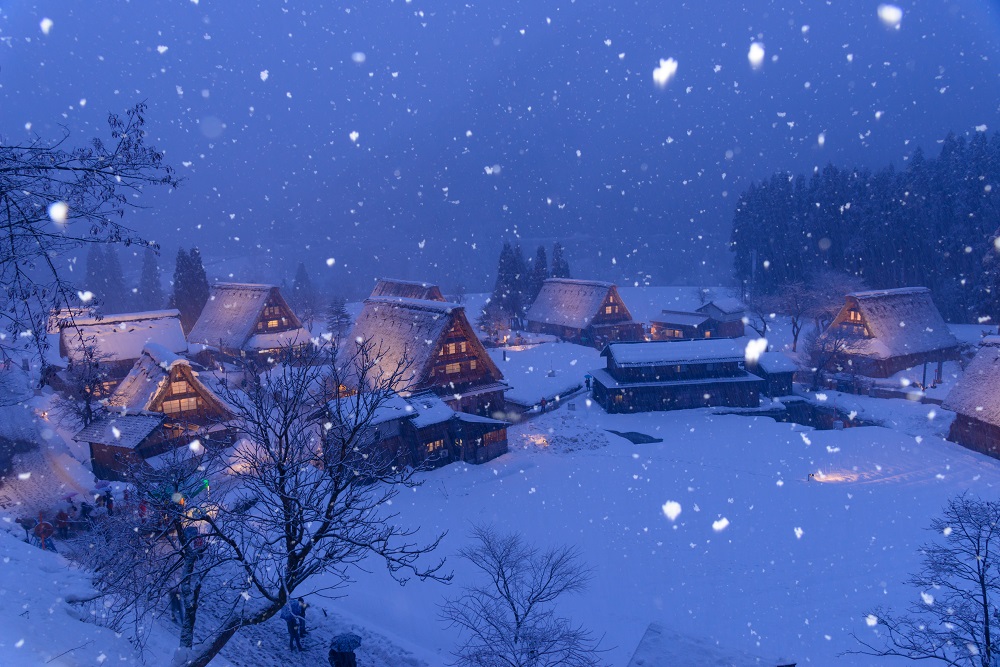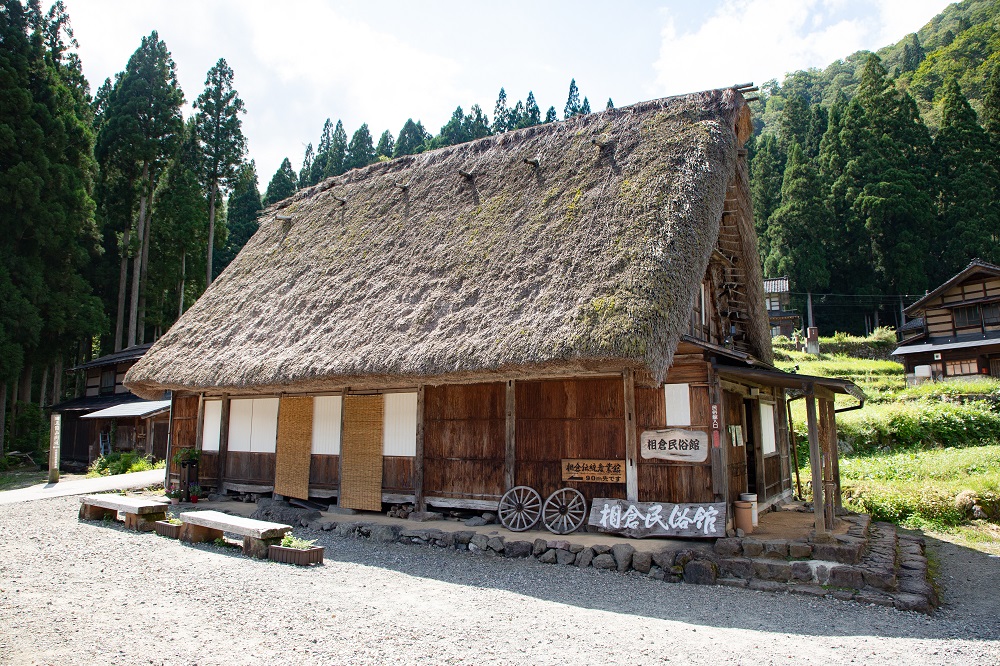Gokayama/五箇山(Toyama)
About Gokayama
Gokayama is a region of forty small villages nestled in abundant nature in Nanto City, Toyama Prefecture, famous for its houses built in the gassho-style, which represent Japan's wooden culture. In 1995, Ainokura and Suganuma, two of the villages in Gokayama, were registered as World Cultural Heritage Sites along with Shirakawa-go in Gifu Prefecture, in recognition of the rural landscape centered on the gassho-style houses and their ethos that has been passed down through the ages. The distance between Gokayama and Shirakawa-go is only 30 km, so you can enjoy all three World Heritage Sites in one trip.

Gassho-style houses have a unique architectural style and are found in Gokayama and Shirakawa-go. The word "gassho" comes from how the shape of the roof resembles the arms of a person putting their left and right palms together when worshipping Buddha, a gesture called “gassho.” The triangular thatched roof, the most distinctive feature of the house, has a steep 60-degree slope to make it easier for snow to slide off, typical of buildings in areas with heavy snowfall. The first floor is used as a living space, and the attic, which is divided into two to four levels, is used as a workspace for sericulture and other activities. The rooms are designed for effective use of space and comfortable living. It is a rational architectural structure born of the wisdom of the people living in this region.

Of the three villages registered as World Heritage Sites, Shirakawa-go is large, Ainokura is mid-sized, and Suganuma is a small village.
Ainokura is surrounded by mountains, and twenty gassho-style houses remain today. People still live in the village, and you can catch a glimpse of life as it was in the past. Visitors can also learn about the history of Gokayama and experience paper-making, a thriving industry in the area, at the museum and facilities located in gassho-style houses. In winter, the entire village is covered with snow, creating a magical silvery-white world.

Suganuma is a small village nestled on the Shogawa River, where nine gassho-style houses remain. Gokayama Folk Museum in the village displays about 200 daily utensils that show the traditional lifestyle of Gokayama, and at Niter Museum, visitors can see the tools used in saltpeter production, which was a major industry in Gokayama, and learn about the manufacturing process. Visitors can also see the "Kago no Watashi,” (basket ferry,) once used as a means for people to cross the river in Gokayama, which was designated a penal colony during the Edo Period and therefore forbidden from having bridges.
Getting there and around
Train and Bus
■From JR Tokyo Station, take the Hokuriku Shinkansen to Shin-Takaoka Station (approximately 3 hours), take the JR Johana Line from Shin-Takaoka Station to Johana Station (about 50 minutes), board a World Heritage bus from Johana Station, and disembark at either the Ainokura-guchi or Suganuma bus stop.
■From JR Nagoya Station, take the limited express Shirasagi-go to Kanazawa Station (about 3 hours), transfer to the Hokuriku Shinkansen to Shin-Takaoka Station (about 15 minutes), take the Johana Line from Shin-Takaoka Station to Johana Station (approximately 50 minutes), and then take the World Heritage Bus from Johana Station to either the Ainokura-guchi or Suganuma bus stop (about 25 to 40 minutes).
■From JR Osaka Station, take the JR Thunderbird limited express train to Kanazawa Station (approximately 2 hours and 40 minutes), transfer to the Hokuriku Shinkansen to Shin-Takaoka Station (approximately 15 minutes), take the Johana Line from Shin-Takaoka Station to Johana Station (about 50 minutes), and board a World Heritage bus from Johana Station to either the Ainokura-guchi or Suganuma bus stop (approximately 25 to 40 minutes).
Top Tip
Gokayama/五箇山
Of the forty villages in Gokayama, two, Ainokura and Suganuma, are registered as World Cultural Heritage Sites, together with Shirakawa-go in Gifu Prefecture. The gassho-style houses found in Shirakawa-go and Gokayama are filled with the wisdom accumulated over generations of village life. The area is rich in nature and offers beautiful scenery in each of the four seasons.

Paper Making/紙漉き
In Gokayama, you can try your hand at making traditional Japanese washi paper. The liquid used to make washi paper is scooped up onto a bamboo screen, and the fibers are shaken vertically and horizontally so that they become entangled. Japanese paper made in Gokayama is called "Gokayama Washi," and together with “Yatsuo Washi” made in Yatsuo Town, and “Birudan Washi” made in Asahi Town, both in Toyama Prefecture, it is designated as "Etchu Washi," a National Traditional Craft. Why not try making your own original Gokayama Washi?
Iwase House/岩瀬家
Iwase Residence is the largest gassho-style house in Gokayama and Shirakawa-go. It was built about 300 years ago over a period of eight years. Iwase Residence was the residence of the officials who delivered saltpeter, manufactured in Gokayama as an ingredient in black powder, to the Kaga domain. The domain is also known as the "Kaga Hyakumangoku," which boasted an overwhelmingly vast territory compared to other domains, and the building’s majestic appearance is a testament to its prestige. In 1958, it was designated as a National Important Cultural Property.

Ainokura Gassho and Suganuma Gassho Style Village/相倉合掌造り・菅沼合掌造り集落
Light-up events are held several times a year on particular dates at Ainokura and Suganuma. The gassho-style buildings are beautifully illuminated, a rare and unique sight. In winter, the entire area is covered with snow, creating a vista of fantastic light in a silvery-white world. You’ll want to stay and enjoy the beautiful scenery forever! Illumination dates are limited, so you should check the latest information before visiting.

Hot springs in Gokayama/五箇山の温泉
Visitors can also enjoy bathing in hot springs near the gassho-style villages. Kuroba Onsen facing the dam lake is open for day-visitor bathing, where you can see the majestic mountains changing their appearance from season to season, the beautiful scenery reflected on the surface of the lake. Gokayama Onsen also offers overnight stays, and you can soak in the hot springs and relax after a long journey, afterward enjoying meals unique to the area deep in the mountains, filled with wild vegetables and fresh river fish.
Information
Unique Local Experiences
The baskets used to ferry goods and people in the Kago no Watashi are on display on the second floor of the Gokayama Folk Museum in the World Heritage Site Ainokura Gassho-Style Village. In the old days, bridges could not be built as the area was a penal colony, and so a rope was strung between the two banks to suspend a basket, and people or objects were placed in the basket and passed from one bank to the other. Sometimes the ropes broke and people fell into the river.
Travel Advice and Tips
Shirakawa-go Gassho Village in Gifu Prefecture and Ainokura and Suganuma villages in Gokayama in Toyama Prefecture were registered as World Heritage Sites in 1995. Since it is only a 30-minute drive between them, you can enjoy this unique landscape of Japan by visiting both areas in one trip. There is a World Heritage tour bus bound for Gokayama from Shin-Takaoka Station on the Hokuriku Shinkansen Line, so access from Tokyo is also convenient.
